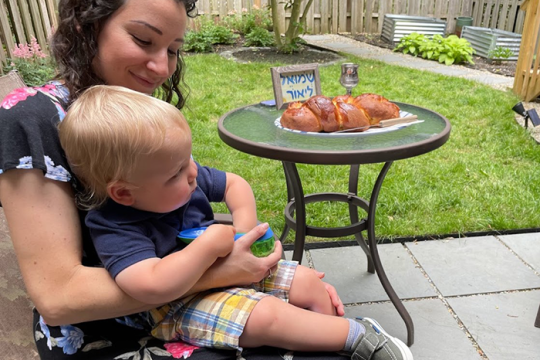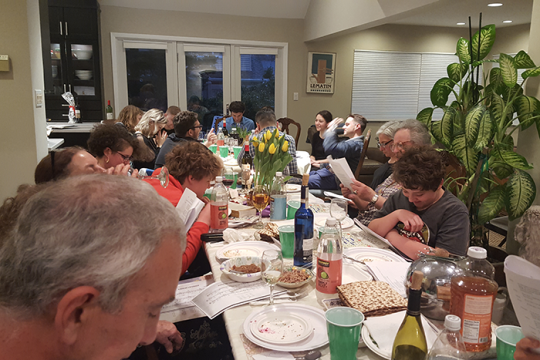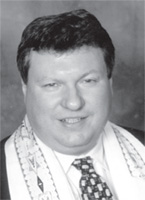
Once again, in a cemetery, I thought about Jewish children. It was our annual Kever Avot (Gravesite of the Ancestors) memorial service, held at both of our community’s historic cemeteries, on the Sunday in between Rosh HaShanah and Yom Kippur. In some ways, there is nothing like a scheduled, non-funeral visit to old graves to get you thinking about Jewish journeys – where we have come from and, perhaps, where we are going.
Sadly, there were few people visiting graves at the older site, the Savan Cemetery, closed at near capacity in the 1830s, and badly in need of restoration. Still, its gravestones in seven different languages tell an amazing story.
There were more people at the “new” site (opened in the mid-1830s?), in Altona, and they, too, tell an amazing story. There, amongst our mixed and multi-racial group – older folks visiting the graves of relatives they remembered, and toddlers hearing tales about people they’d never met – I couldn’t help but think about how different we Jews look today (and will into the future) than we did in the past.
It was there, too, that I thought about the nine Sephardic families that founded the synagogue. Their names are…everywhere on this island. And around the world. They are now faces of every color, bearers of every creed, on the rolls of every church. Soon, I want to organize an evening service, or a weekend of events, called “Roots and Wings,” for every person on these islands who has Jewish roots of some sort, or who is interested in Judaism, or who has heard of it, or who can spell it… It will be, I think, a long list of invitees. Whether many or few will be interested I don’t know; we can only find out by trying.
But looking back to see who we are and where we might go is kind of a thing these days. All it takes is spitting into a mail-away test tube, or some other form of sharing yourself – with the commercial DNA-testing labs that offer such services.
I saw that a colleague spoke about 23andMe, the direct-to-consumer genetic testing company, during the High Holidays this year. What a great topic – at least for Ashkenazic Jews. Part of the information you get, apparently, is what percentage “Ashkenazic Jewish” you are. I think I read that Sephardic roots are simply characterized as “Middle Eastern,” rather than Sephardic Jewish.
Whatever the science behind the distinction, it raises interesting questions. And those questions lead to more questions.
What is a creed, and what is a culture? How much of who we are is about where we are from? How will knowing the past impact us in the present? Does our genetic history matter for more than medical purposes – and if so, why, and how, and to whom? And: look at how many white-bread-with-mayonnaise eating middle Americans are discovering something about themselves they never knew, this newish Jewish part of them? What will they do with the information? How will this change them?
And, most chillingly, I often wonder this: what drove so many away? Indifference, oppression, opportunities? Or was it, perhaps, a closed-circle within our own community, cliquishness, making someone feel “other” and “out?” Some of the stories I have heard here center around grandparents who did not feel welcome, or wanted, and who found a spiritual home elsewhere.
I don’t want to go too far down that road. Sometimes, I am astonished that Jews find it so very easy to set aside a 4,000-year old history and dynamic culture and intellectual inheritance not because of spiritual questions (although there is some of that), but because somebody (sadly, often a rabbi) looked at them the wrong way. Yes, we make mistakes, we act imperfectly, and we turn each other off. I have staked my own work, my passion, my devotion to the notion that, for most of us, and most of the time it is deeply worth it… to get past the flaws and bumps and bruises, however they may hurt.
But it is time for those “inside” the Jewish orbit to redouble or triple our efforts – to be more open, to be more welcoming, to reach out, to break up our cliques and widen our circles. Because this is not just about liquid in a test tube, or information in an envelope (or email). And whether someone comes back with results that are 85% “Jewish” roots, or none at all, the ability even to ask indicates fluidity and curiosity, about identity and connection and community.
Science impacts society. The physical affects the spiritual. Just look at the religious changes brought about… by the printing press. Or the phone. Or the car.
People today are using new techniques to ask old questions. They are looking back at an internal yesterday. It is a perfect moment to build a better tomorrow.
Related Posts

Harnessing the Power of our Mothers Around the Seder Table

Melding Tradition and Innovation: Our Interfaith Toddler Naming Ceremony


